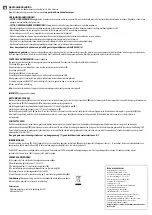
Chapter 1. Overview
1-4
-
Multi Detector Sounder Base, Canadian (4098-
9795C)
-
Multi Detector Base w/LED (4098-9796)
-
Multi Detector Base w/LED, Canadian (4098-
9796C)
MONITOR MODULES
•
The 4090-9001 Supervised Monitor is a contact closure
monitor capable of quad sensing (normal, open, short,
and current-limited conditions). It is a line-powered
device and consumes one address.
•
The 4090-9101 (Class B) and 4090-9106(Class A)
Addressable Modules are input devices capable of quad
sensing (normal, open, short, and current -limited condi-
tions). This device requires separate 24 V power and
consumes one loop address.
•
The 4099-9001 (single action) and 4099-9002/4099-
9003 (dual action) addressable pull stations are latching
pull stations that can be reset with a key. They are a line-
powered device, consuming one address.
CONTROL MODULES
•
4090-9002 Relay Module is line-powered and contains
a Form-C relay that can be used to control auxiliary
functions (such as elevator recall).
•
4090-9116 Isolator Module allows the addressable
device loop to continue to function under certain fault
conditions.
•
4090-9007 Signal Zone.
Programming Overview
A
job
refers to the file containing all of the panel’s program-
ming information. A job (also called a CFIG file) can be pro-
grammed in one of two ways.
•
Automatic Programming (Chapter 3).
The panel’s
auto-program option provides the ability to quickly and
automatically program the panel’s components and fea-
tures. This option does the following:
-
Scans the panel’s serial communication channel,
adding any annunciators.
-
Scans the IDNet channel, adding and configuring
IDNet devices.
-
Adds any installed option cards, such as an AUX
relay module or city circuit card.
-
Performs a duplicate address search, terminating
the operation if a duplicate address is found.
-
DACT information (phone numbers and account
information) must be manually programmed.
It is recommended that you use the automatic program-
ming option to perform the following tasks.
-
Initial programming. After all option cards are
installed and all devices are addressed and wired,
use the auto programming feature to add the cards
and devices to the job. After automatic program-
ming the panel will function as a general alarm
panel, assuming all devices are wired correctly. At
that point, you can use manual programming to edit
labels, device functions, and alarm groups if neces-
sary.
-
Adding new cards or points to a previously pro-
grammed job.
•
Manual Programming.
This programming option
allows you to individually change the attributes of each
point, including:
-
Function Type. Determines the way in which the
point operates (i.e., fire point, trouble point, on til
silence, etc.).
-
Custom Label. Automatic programming assigns a
generic label -- such as P1, NAC1, or AUX1 -- to
each point. Manual programming allows you to
assign a 20-character, site-specific label to each
point.
-
Alarm Group. Allows inputs and outputs to be
associated into groups to implement selective sig-
naling applications.
System Options
System options are pre-defined modes of operation with a
range of settings from which to choose. System Options
define global operations such as the time and date format,
door drop timers, and whether the city circuit is enabled, etc.
System options can be set during either the automatic man-
ual programming process.
Alarm Groups
Alarm groups allow you to implement basic selective signal-
ling applications. As you program input (smoke detectors,
monitor zones) and output points (NAC, signal zone, relay),
you are given the opportunity to associate the point with an
alarm group number. The number can range from 1-99 and
each point can be in up to three alarm groups. When pro-
gramming is complete, an initiating device can only trigger
the output devices (relays, NACs) that share its alarm
group(s).
Single Station Operation
Single Station is a mode of operation that applies to IDNet
devices that use a sounder base (the sensor can be either
photo, heat, or combination photo/heat).
Technical Manuals Online! - http://www.tech-man.com
firealarmresources.com
Summary of Contents for TrueAlarm 4008- 9121
Page 1: ...Technical Manuals Online http www tech man com firealarmresources com...
Page 6: ...Technical Manuals Online http www tech man com firealarmresources com...
Page 10: ...Technical Manuals Online http www tech man com firealarmresources com...
Page 34: ...Technical Manuals Online http www tech man com firealarmresources com...
Page 58: ...Technical Manuals Online http www tech man com firealarmresources com...
Page 68: ...Technical Manuals Online http www tech man com firealarmresources com...
Page 72: ...Technical Manuals Online http www tech man com firealarmresources com...
Page 80: ...Technical Manuals Online http www tech man com firealarmresources com...
Page 85: ...Technical Manuals Online http www tech man com firealarmresources com...
Page 86: ...Technical Manuals Online http www tech man com firealarmresources com...















































